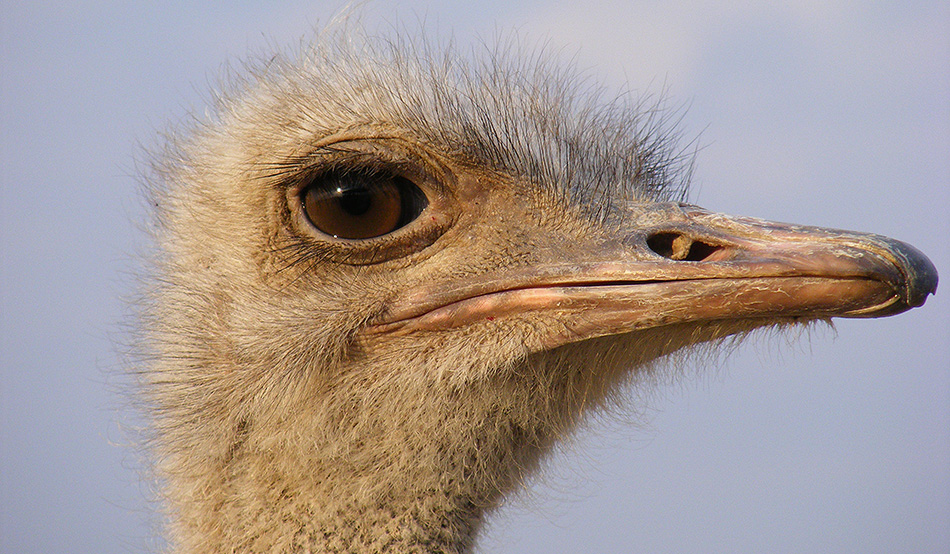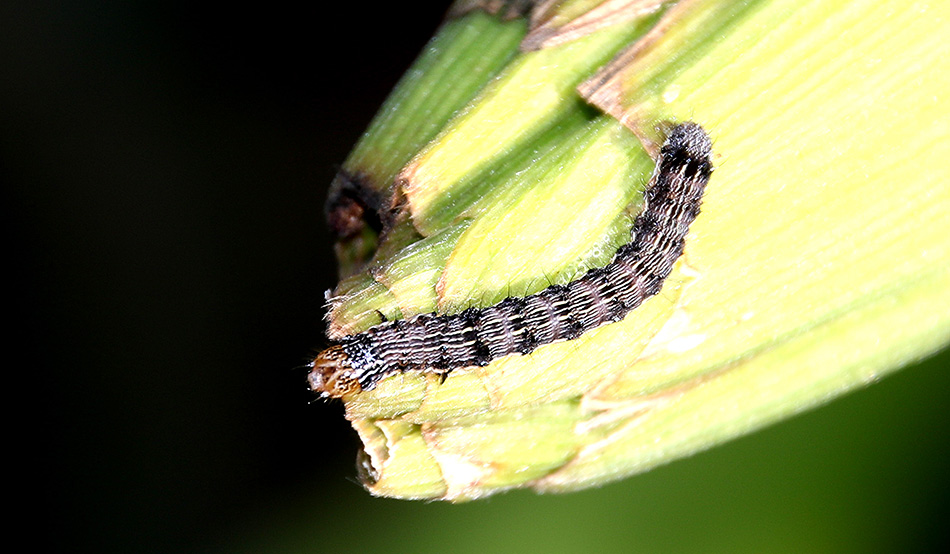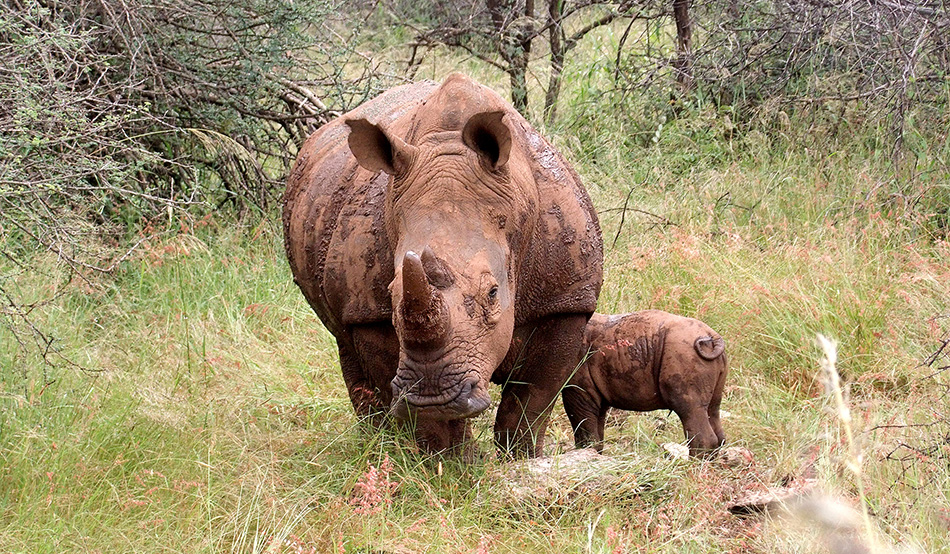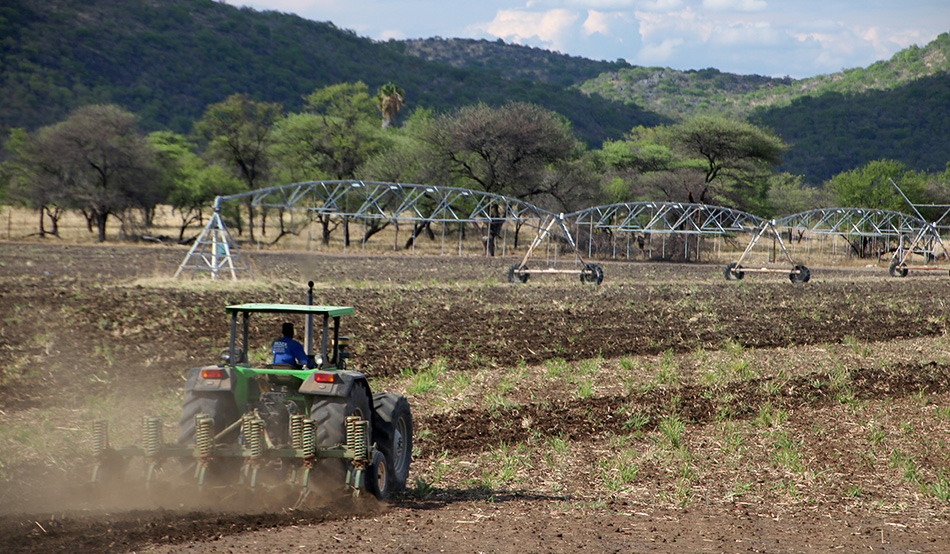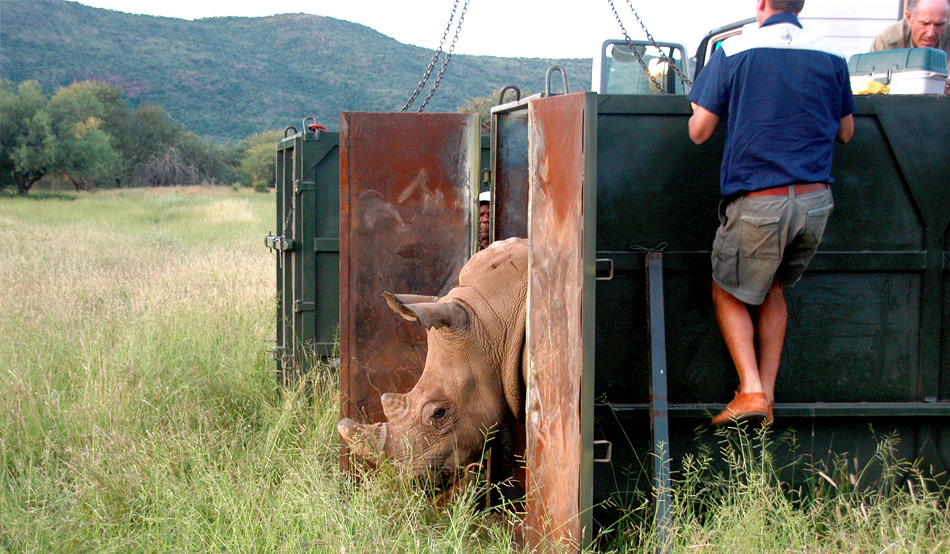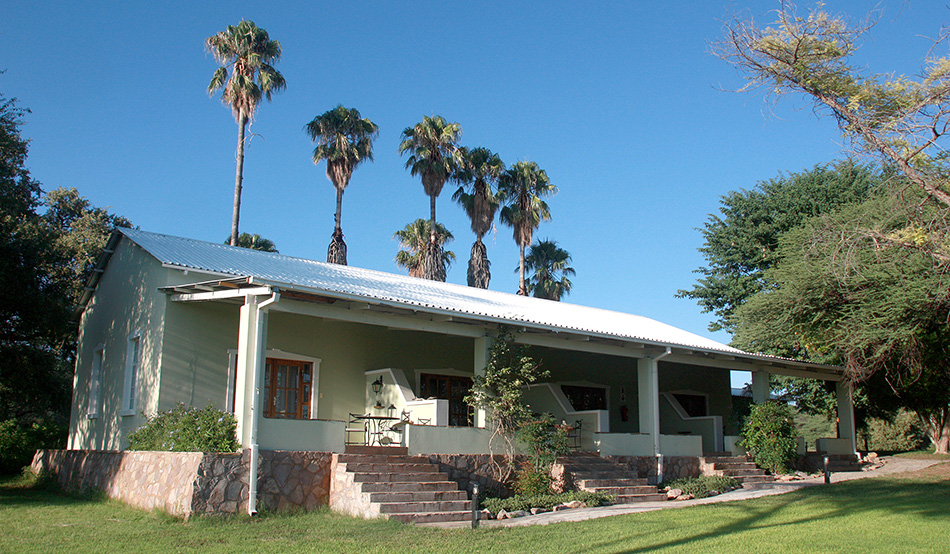News from Ghaub
Your oasis in the Otavi mountainsYou like to stay up to date with what is happening at Ghaub? Subscribe to our newsletter. It is published every three months and contains a potpourri of stories about rhinos and other exciting topics as well as news about Ghaub and its partner companies Waterberg Wilderness (at the Waterberg) and Ondekaremba (at the airport).
Little Etosha in the Otavi mountains
The Ghaub Nature Reserve is evolving into a very diverse game paradise. Since the beginning of May, with a little luck guests can spot two further animal species, without which you cannot imagine the African bush savannah: Ostrich and giraffe.
In the first week of May three male and five female ostriches were released to the Ghaub Nature Reserve. The plains in the wide valley in the Otavi Mountains, with their grass and bush offers an ideal habitat.
Two weeks before, a transport with special containers arrived, equipped with particularly high walls because of their cargo: Twelve giraffes. These elegant giants of Africa were also living in this area before the founding of the mission station and the farm.
Thus, Ghaub continues its programme for reintroduction of game. Last year oryx antelopes and impalas as well as white rhinos were released. Ghaub is also home for species such as eland, red hartebeest, blesbok and kudu as well as klipspringer, duiker, damara dik-dik and warthog.
Guests can spot the animals on a Rhino Drive or a Rhino Tracking Tour, as well as from the hide at the waterhole near the swimming pool.
Ghaub fights against caterpillar from South America
Just as good rains in Namibia promise a good maize harvest, bad news strike: A caterpillar plague threatens maize fields in the countries of southern Africa. At Ghaub the so-called Fall Army Worm was discovered, too. Now it was crucial to act swiftly...
"We noticed a strong attack by the Fall Army Worm in February," says maize farmer Hartmut Freyer, who is responsible for the fields on Ghaub. "You have to act quickly, because the life cycle from the caterpillar to the moth laying eggs takes only 21 days. We treated the fields with pesticides at the end of February and brought the infestation under control."
Depending on the wind, this moth can travel up to 1,200 kilometers within 30 hours. It originates from South America, was introduced to Central Africa and now also threatens countries in Southern Africa.
In the north of Namibia it was not the Fall Army Worm, but the indigenous "Bollworm", which destroyed the whole maize harvest on the government farming area Etunda (see reports in the Namibian on 23 January and 6 April). This type of caterpillar, gnawing on the tip of the corn cob, has now been sighted at Ghaub, too. However, according to Freyer it does not pose a great threat, because the corn is already in the process of ripening: It passed the “milk” and “flour” phases and the grains now begin to harden. The only risk might be rain, which could lead to fungal infestation at the spots that have been nibbled at.
At Ghaub maize is cultivated on 140 hectares, of which 32 hectares can be irrigated. The harvest is expected beginning of June. On a farm tour, guests of Ghaub Nature Reserve and Farm will learn more about cultivation, hay production, cattle breeding and game farming.
Two rhino babys born at Ghaub
The rhinos settled in well since their arrival at Ghaub in March last year. The best proof of this is twofold offspring: Both cows in reproductive age have given birth to a baby. However, the small ones were already conceived 500 kilometers away near the International Airport east of Windhoek...
In early March the young cow gave birth to a heifer calf, and a few weeks later the older cow followed with a bull calf. Although the five rhinos which were released in March a year ago appeared to be feeling comfortable in their new surroundings already a few weeks after their arrival, the births now clearly show that Ghaub with its grassy plains is an ideal home for them.
White rhinos carry their young for 16 months. This means that the offspring were already conceived at the previous location: At Ondekaremba, the partner company of Ghaub at Hosea Kutako International Airport east of Namibia's capital Windhoek. It also indicates that the two carrying cows have coped well with the stress caused by the capture and the transport of approximately 500 kilometers.
Guests of Ghaub can experience the rhinos close up on a Rhino Drive and a Rhino Tracking Tour. However, for safety reasons and in order to spare the two cows and their calves unnecessary stress, in the first weeks the guides keep a much larger distance to the animals.
Ghaub tills its fields
While almost all people in Namibia are preparing for the summer holidays at the end of November, farmers in the Otavi mountains are rolling up their sleeves: The fields have to be ploughed so that the maize can be sown, because the magic rain mark has been exceeded...
According to an old country lore there must have been 100 mm of rain before you can sow maize. However, one must not wait too long, because the rainy season in Namibia only lasts until April / May. Therefore, last deadline is the end of January.
In order to thrive, the plants need at least 300 mm of rain in the period from the end of January to the end of March – without long dry periods in between. Harvest time is in the months of June or July.
At the end of November, Ghaub was busy tilling the fields, beacause at that time there had been enough rain. Maize is cultivated on 200 hectares, of which 32 hectares are under irrigation. The Otavi mountains receive on average much more rain than the surrounding area and are therefore known as maize area.
On a farm tour, guests of Ghaub will find out everything about the cultivation of maize, which is exceptional for Namibia: Because of the low rainfall the majority of the farm land is only suitable for livestock farming. Cattle and sheep farming on the 60 km² farm area as well as game farming in the nature reserve of about the same size are further exciting topics of the tour.
Namibia’s heraldic animal back home in Ghaub
Our valley in the Otavi mountains has 40 new inhabitants: 18 Oryx and 22 impalas have arrived in the Ghaub nature reserve on a game transporter. Visitors taking our Rhino Drive now have two more game species to discover.
The capturing of the game on a farm near Otjiwarongo went smoothly, as did the two hour transport and the release at Ghaub. The antelopes were happy to jump into freedom over a provisional ramp next to the transporter. They immediately started exploring their new home.
We specifically chose these two species because they had become quite rare in this area and the living conditions are ideal on Ghaub. Rainfall is considerably higher in the Otavi mountains than in the surroundings and therefore grass grows higher and more abundantly.
We specifically chose these two species because they had become quite rare in this area and the living conditions are ideal on Ghaub. Rainfall is considerably higher in the Otavi mountains than in the surroundings and therefore grass grows higher and more abundantly.
With our game reintroduction programme we want to strengthen the populations and re-establish a variegated and robust ecosystem. We only reintroduce species which originally occurred in the region, as was the case with the white rhinos that arrived in April. Ghaub is also home to eland, red hartebeest, blesbok and kudu as well as klipspringer, duiker, Damara dik-dik and warthog. Sometimes tree squirrels visit the restaurant patio, much to the delight of our human patrons.
Surf service at the reception
From the Rhino Drive to facebook: Visitors of Ghaub Lodge can now immediately share their adventures, such as close encounters with rhinos, with family and friends all over the world. The new WLAN was installed end of September. For now reception is limited to the lodge restaurant.
Access to mobile telecommunication and Internet are still scarce in many areas of Namibia. In order to ensure better reception at Ghaub, we established a direct connection to a distribution point on a mountain near the tar road between Tsumeb and Otavi.
One should however not expect Internet speed and reliability of urban European standard. Internet provider Telecom Namibia has to supply a developing country twice the size of Germany, but with a population only roughly the size of Paris, i.e. 2.3 million people.
Rhinos conquer valley in the Otavi mountains
Visitors to Ghaub pinch themselves in disbelief: Are those rhinos in the bush savannah? Yes, those are in fact rhinos. White rhinos, to be precise. They were released at the end of March, after the game sanctuary was fenced and measures for their protection were put in place.
The impressive pachyderms have in the meantime recovered from the transport and have settled well in their new surroundings. They seem completely relaxed when a game viewer vehicle approaches them. We see the rhinos on almost every game drive because every day a ranger of the "Rhino Patrol" tracks them and gives their location to the guide via radio.
White rhinos are larger, but more placid than the black rhinos mostly sighted in Etosha. In Namibia they are also the less common of the two species. Once our rhinos are used to the daily visits by humans, our guests will be able to get out of the car and approach them on foot. The guide and tracker present carefully watch their body language and immediately alert the viewers, if an animal seems nervous or irate.
With a little luck you can also see other game like eland, hartebeest, blesbok and kudu on the game drive. You are guaranteed to see an elephant, or rather the portrait of an elephant, engraved on a rock at a time when elephants still roamed the whole of Namibia.
Ghaub Lodge in new hands
The farm Ghaub with its eponymous lodge in the Otavi mountains changes hands and thus becomes a partner of the private nature reserve Waterberg Wilderness (at the Waterberg) and the Ondekaremba Lodge (at the airport). The previous owner and former flight entrepreneur André Compion moves to South Africa because of private reasons. Operation of Ghaub Lodge continues as usual.
Ghaub is well-known for its stalactite cave, the third largest cave Namibia, which guests can explore on a guided tour. Quite remarkable for Namibia is also the cultivation of maize, which is shown together with the cattle on a farm tour. The game rich nature reserve of Ghaub is home to antelopes such as eland, red hartebeest and blesbock. With more than 250 species of birds the area is a haven for birdwatchers.
Ghaub charms its visitors by its historic atmosphere of the former mission station, built by the Rhenish Missionary Society in 1895. The whole facilities have been lovingly renovated and expanded by buildings kept in the same style.
